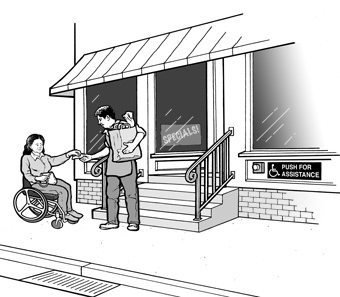






Offering goods and services in other ways
When a barrier prevents access to a business’s goods or services and removing it is not “readily achievable” (as discussed in lesson 4), the ADA expects businesses to offer their goods and services to people with disabilities in other ways that are “readily achievable.”

A restaurant provides home delivery to a family who
is not able to eat in the restaurant due to barriers.
 |
 |
|
|
|
You may not charge people with disabilities higher prices to cover the cost of providing service in an alternative way. For example, a restaurant may not charge a person who uses a wheelchair extra for home delivery when it is provided as the alternative to barrier removal.
Businesses that provide curb-side service should install a buzzer or bell so the customer can signal for service.
|
|
|
|
|
|




